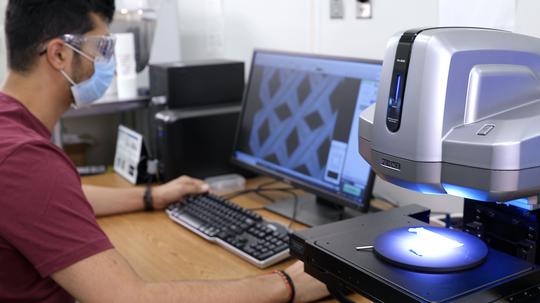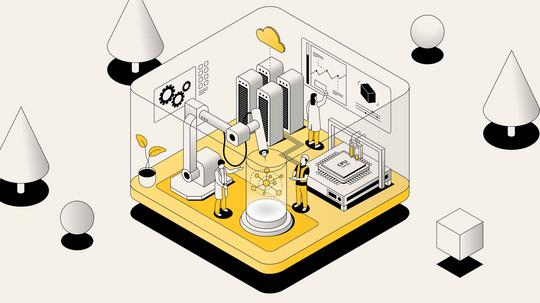
As part of a statewide plan to grow and develop Arizona’s expanding high-tech industry, part of the state’s New Economy Initiative that involves all three state public universities, Arizona State University is building five science and technology centers.
The centers are laboratories where university faculty, with the help of students, work with private companies to drive change in the dynamic industries that already are shaping our future. One of the two launched this year is the Advanced Manufacturing Science and Technology Center, located on ASU’s Polytechnic campus in Mesa. The university calls it MADE: manufacturing, automation and data engineering.
In the following Q&A, Dhruv Bhate, an associate professor in the School of Manufacturing Systems and Networks, one of seven schools in ASU’s Ira A. Fulton Schools of Engineering, talks about its role, what relationships with industry will look like and what form success will take.
Question: What role will advanced manufacturing play in the new economy?
Manufacturing of the future is going to involve three fundamental pillars that are pushing the edge of what we have done, what has come before, and taking it into new territory to provide new services, products and completely new materials. The first of these is what we call process science and engineering. The second of these is robotics and automation. And finally, the third is data analytics, cybersecurity and AI (artificial intelligence).
What ties these three together is what we are calling advanced manufacturing. And that is where we believe the jobs of the future are going to be created. That’s what we believe will form the foundation for innovation in the future, be it in the form of IP (intellectual property), be it in the form of companies that spin off to create new products or to create new materials or new processes that enable new products.
Q: What will additive manufacturing — 3D printing — enable?
In the past, materials were limited. You had plastic, metal, ceramics and composites. Additive manufacturing has turned all that on its head. With 3D printing, materials can be combined in ways that were previously impossible. Materials performance can be improved more than it has before.
Let’s say you want to build a crash structure for protection in a helicopter. The pilot is held up with one structure and energy from a crash is absorbed with another structure. With additive manufacturing, the two can be combined, using less material and reducing weight with a few different solutions, taking it to the next level and involving design to get further advances.
Q: Nanotechnology (the use of matter on an atomic, molecular and supramolecular scale for industrial purposes) is on the cutting edge. It’s a technology that’s applicable to many industries and products. What are the challenges to adopting it widely?
The challenge with nanotechnology has been scaling it. I can make some in the lab, but how do I scale it up to where there are paints with nanomaterials that may reduce the cost of the paint or reduce the environmental footprint? Now we are talking about scaling up technologies from the lab to manufacturing scales, where they can actually have an impact on the market.
When thinking about how to scale that, we’ve often been doing this in an ad hoc trial-and-error manner. What has changed in many ways is data and our ability to use data in ways that we were not before. Now, we can use data to make improvements on processes much faster than before. We can, with the help of automated tools like micro microscopes and testing machines, generate an understanding of the big behavior of these structures. We can use techniques such as data analytics and machine learning to tell us how to change the process to improve it and make it the next-generation material. Nanomaterials with computational tools allow us to design structures in ways we could not before.
Q: What types of problems do companies show up with?
A lot of companies have invested in new manufacturing processes, or they want to explore a new material. It’s all very well to fabricate a new material in a lab, but if you want to put it on an aircraft, you have a lot of steps to go through. Can I develop that new alloy that can resist even higher temperatures than what I’ve been able to do before? This is what we would call mid-technology readiness, where it works in the lab, but will the Federal Aviation Administration (FAA) certify this part? And for us to bridge that gap from the lab to a component flying on an aircraft, we need a lot of data, and we’ve got be smart about this data collection today.
Every time we introduce a new metal, say for a 3D printing system, it takes us a year to a couple of years and a million dollars or so to generate the kind of data that we need to certify a process, material or part. Companies come to us for two levels of engagement.

One is on the fundamental research side, where we have the deep knowledge expertise and the technical capabilities to help companies evaluate the fundamental research side of things, but also to engage in the gap between lab to market, the so-called “valley of death” where innovation is not able to translate and have an impact in the market.
At the MADE Center, we use our test equipment, our characterization equipment, along with computational tools such as data analytics and machine learning to essentially get that data to be smarter than we have before, with much less of an investment than we have before. Where the old philosophy has been to get a certain number of samples, the new philosophy is, can I do that with fewer samples, but then use data analytic techniques to let me scale and bridge the gap where I get sufficient data to certify my material?
Q: What will success look like?
If we fast forward a couple of years, we’ll have an ecosystem of faculty members, industry partners and students and staff all working together to solve problems and push Arizona leadership in advanced manufacturing, creating that next wave of jobs that have been born from initiatives and ideas and projects that came out of the STC (Science and Technology Center). If we see that happening, that means we’ve been successful.
To learn more, watch this video on developing factories of the future: youtube.com/watch?v=iLE1ja8KZLI.


